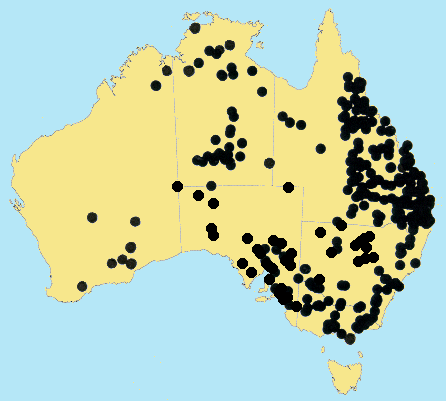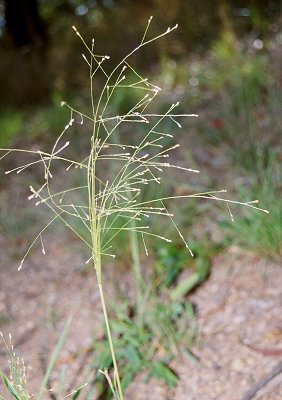Panicum effusum R. Br. Prodr. 191
(1810).
Classification. (GPWG 2001) : Subfamily
Panicoideae. Paniceae.
Type of Basionym or
Protologue Information: HT: R. Brown 6105, Australia (BM; IT: K).
Key references
(books and floras): [1810]. R.Brown, Prodromus (191), [1878]
G.Bentham, Flora Australiensis 7 (488), [1952] C.A.Gardner, Flora of
Western Australia 1 Gramineae (258), [1981] M.Lazarides in J.Jessop
(ed)., Flora of Central Australia (472), [2002] D.Sharp & B.K.Simon,
AusGrass, Grasses of Australia, [2006] J.Jessop, G.R.M.Dashorst,
F.M.James, Grasses of South Australia (461), [2008] S.W.L.Jacobs,
R.D.B.Walley & D.J.B.Wheeler, Grasses of New South Wales.
Illustrations:
[2006] J.Jessop, G.R.M.Dashorst, F.M.James, Grasses of South Australia (461, fig. 393 as var. effusum), [2008]
S.W.L.Jacobs, R.D.B.Whalley & D.J.B.Wheeler, Grasses of New South Wales,
4th edn (315).
Habit. Perennial. Rhizomes present. Stolons absent. Culms erect or
geniculately ascending, 2–100 cm tall, 2–7 -noded. Mid-culm internodes
glabrous. Mid-culm nodes glabrous or pubescent. Lateral branches simple or
sparsely branched. Leaves mostly basal. Leaf-sheaths hairy. Leaf-sheath
auricles absent. Ligule a fringed membrane, a ciliate membrane, 1 mm long.
Leaf-blades linear, flat or involute, 5–25 cm long, 2–6 mm wide. Leaf-blade
surface smooth or scabrous, indumented.
Inflorescence.
Inflorescence compound, a panicle. Panicle oblong, effuse, 8–50 cm long, evenly
furnished or with spikelets clustered towards branch tips.
Spikelets.
Spikelets pedicelled. Fertile spikelets 2-flowered, the lower floret barren
(rarely male), the upper fertile, comprising 1 basal sterile florets,
comprising 1 fertile floret(s), without rachilla extension, lanceolate or
ovate, dorsally compressed, 2–3 mm long. Rhachilla internodes elongated between
glumes.
Glumes. Glumes
thinner than fertile lemma. Lower glume ovate, membranous, without keels, 3–5
-nerved. Lower glume apex muticous. Upper glume lanceolate or ovate, 2.2–2.8 mm
long, membranous, without keels, 5 -nerved. Florets. Basal sterile
florets 1, barren, with palea or without significant palea. Lemma of lower
sterile floret 90 % of length of spikelet, membranous, 7 -nerved, muticous.
Fertile lemma 1.5–2.2
mm long, without keel. Lemma apex muticous. Anthers 3.
Continental
Distribution: Tropical Asia and Australasia.
Australian
Distribution: Western Australia, Northern Territory, South Australia,
Queensland, New South Wales, Victoria, Norfolk I.
Western Australia:
Fitzgerald. Fortescue, Ashburton, Austin. Coolgardie. Northern Territory:
Darwin & Gulf, Victoria River, Central Australia South. South Australia:
North-western, Lake Eyre, Nullabor, Gairdner-Torrens Basin, Flinders Ranges,
Eastern, Eyre Peninsula, Northern Lofty, Murray, Yorke Peninsula, Southern
Lofty, South-eastern. Queensland: Burke, Burnett, Cook, Darling Downs,
Leichhardt, Maranoa, Mitchell, Moreton, North Kennedy, Port Curtis, South
Kennedy, Warrego, Wide Bay, Gregory North. New South Wales: North Coast,
Central Coast, South Coast, Northern Tablelands, Central Tablelands, Southern
Tablelands, North-Western Slopes, Central-Western Slopes, South-Western Slopes,
North-Western Plains, South-Western Plains, North Far Western Plains, South Far
Western Plains. Victoria: East Gippsland, Eastern Highlands, Gippsland
Plain, Grampians, Midlands, Murray Mallee, Riverina, Volcanic Plain, Wimmera.
Notes. In tropical
and subtropical wet sclerophyll forests, Brigalow forests, tropical and
subtropical sub-humid woodlands, temperate sub-humid woodlands, semi-arid shrub
woodlands, arid and semi-arid low woodlands, arid tussock grasslands, and arid
hummock grasslands. Flowers throughout the year.








